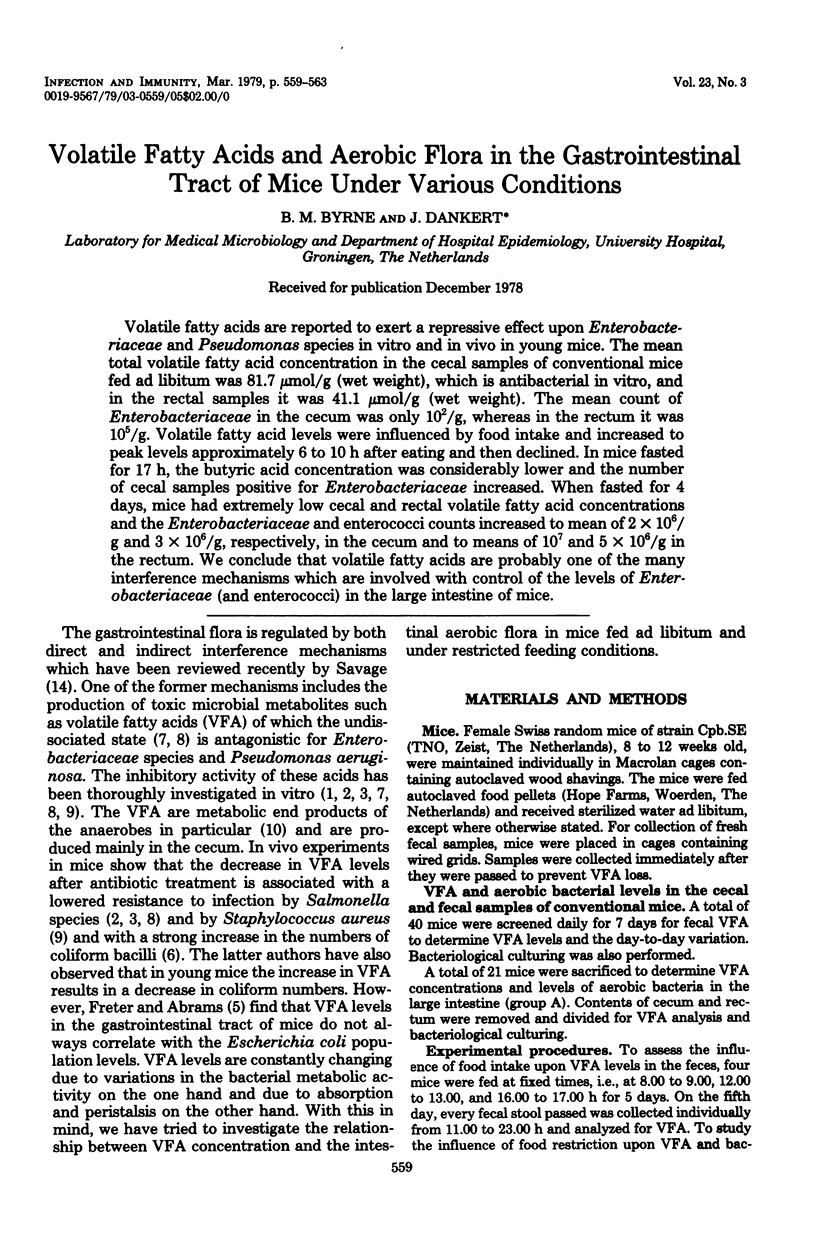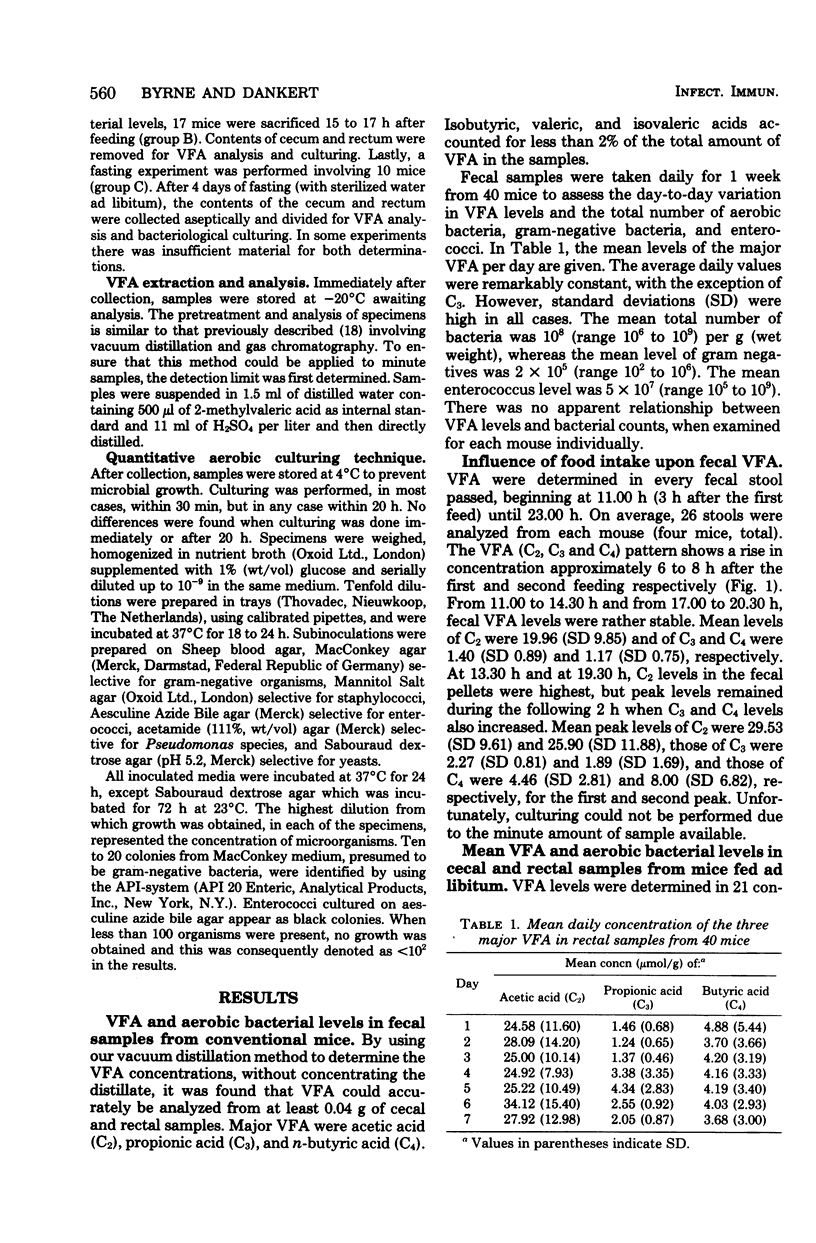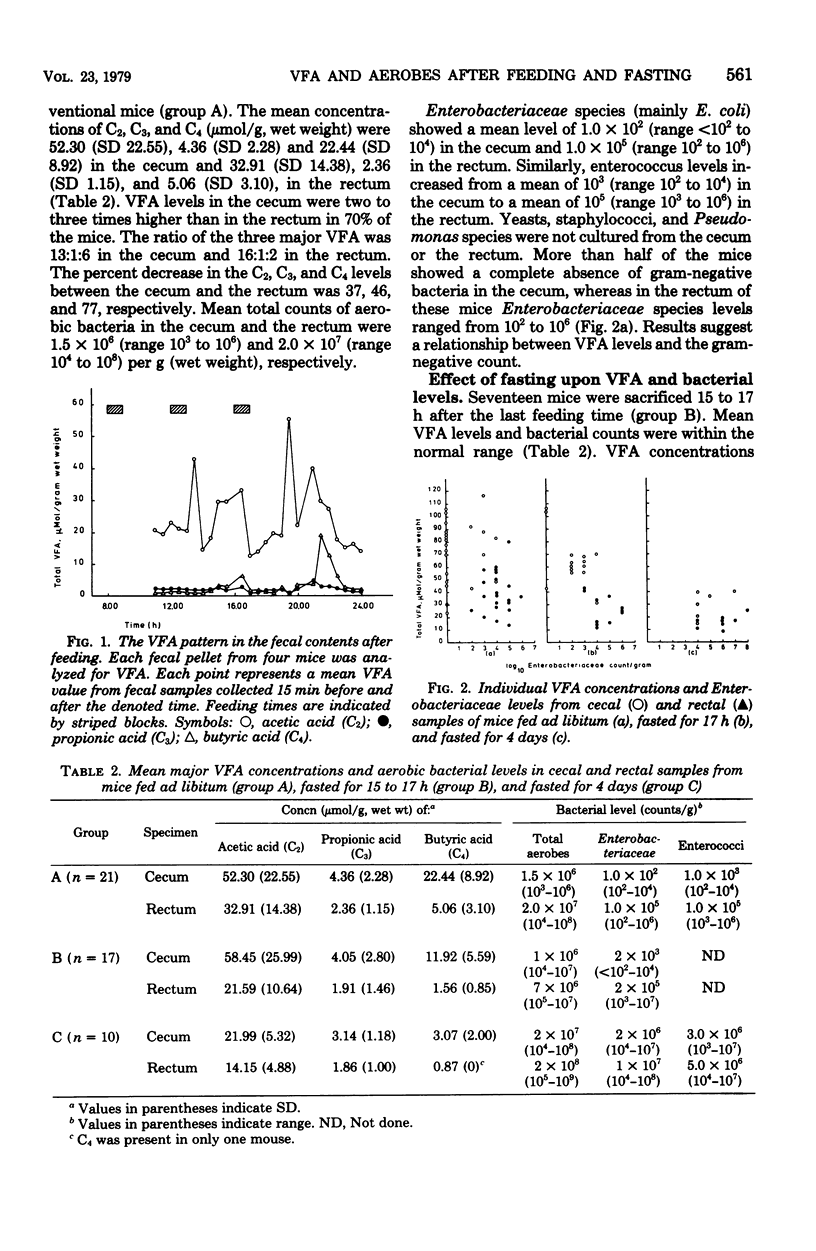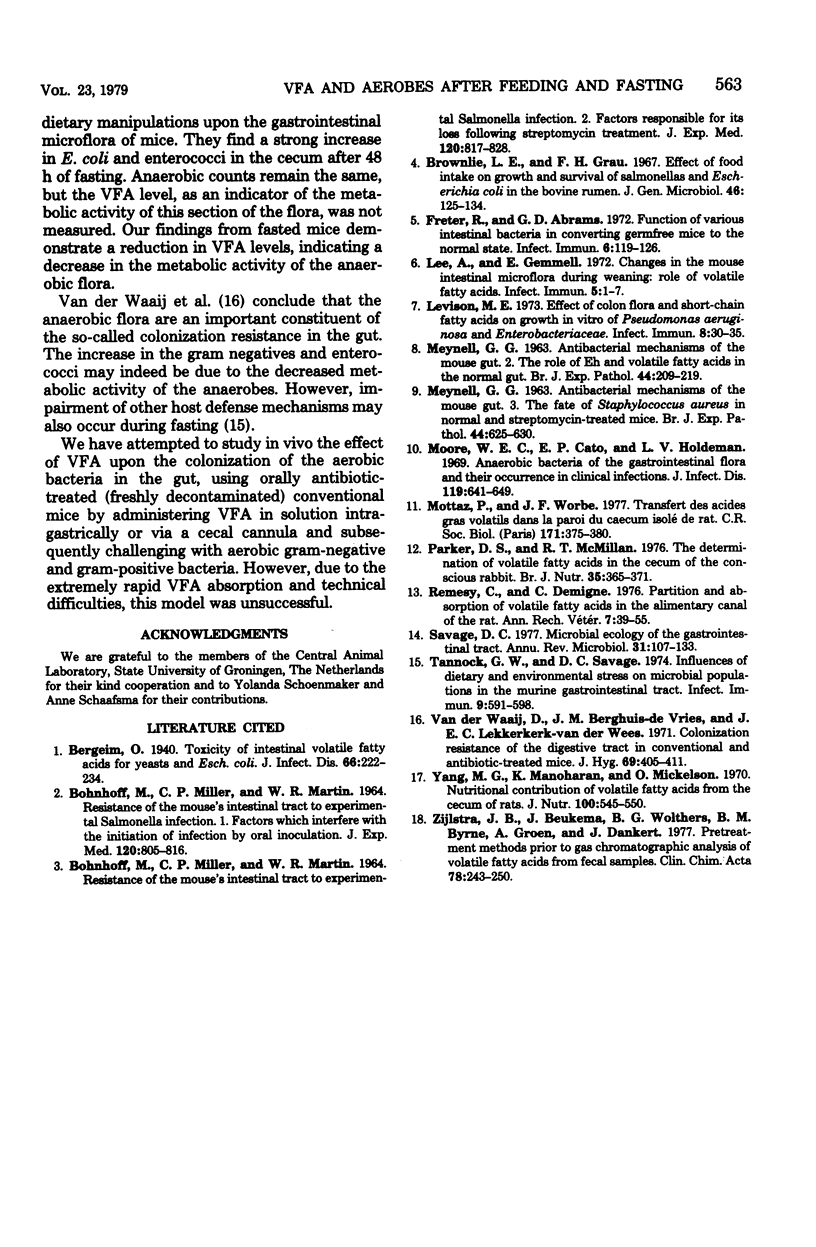Abstract
Volatile fatty acids are reported to exert a repressive effect upon Enterobacteriaceae and Pseudomonas species in vitro and in vivo in young mice. The mean total volatile fatty acid concentration in the cecal samples of conventional mice fed ad libitum was 81.7 mumol/g (wet weight), which is antibacterial in vitro, and in the rectal samples it was 41.1 mumol/g (wet weight). The mean count of Enterobacteriaceae in the cecum was only 10(2)/g, whereas in the rectum it was 10(5)/g. Volatile fatty acid levels were influenced by food intake and increased to peak levels approximately 6 to 10 h after eating and then declined. In mice fasted for 17 h, the butyric acid concentration was considerably lower and the number of cecal samples positive for Enterobacteriaceae increased. When fasted for 4 days, mice had extremely low cecal and rectal volatile fatty acid concentrations and the Enterobacteriaceae and enterococci counts increased to mean of 2 x 10(6)/g and 3 x 10(6)/g, respectively, in the cecum and to means of 10(7) and 5 x 10(6)/g in the rectum. We conclude that volatile fatty acids are probably one of the many interference mechanisms which are involved with control of the levels of Enterobacteriaceae (and enterococci) in the large intestine of mice.
Full text
PDF




Selected References
These references are in PubMed. This may not be the complete list of references from this article.
- BOHNHOFF M., MILLER C. P., MARTIN W. R. RESISTANCE OF THE MOUSE'S INTESTINAL TRACT TO EXPERIMENTAL SALMONELLA INFECTION. I. FACTORS WHICH INTERFERE WITH THE INITIATION OF INFECTION BY ORAL INOCULATION. J Exp Med. 1964 Nov 1;120:805–816. doi: 10.1084/jem.120.5.805. [DOI] [PMC free article] [PubMed] [Google Scholar]
- BOHNHOFF M., MILLER C. P., MARTIN W. R. RESISTANCE OF THE MOUSE'S INTESTINAL TRACT TO EXPERIMENTAL SALMONELLA INFECTION. II. FACTORS RESPONSIBLE FOR ITS LOSS FOLLOWING STREPTOMYCIN TREATMENT. J Exp Med. 1964 Nov 1;120:817–828. doi: 10.1084/jem.120.5.817. [DOI] [PMC free article] [PubMed] [Google Scholar]
- Brownlie L. E., Grau F. H. Effect of food intake on growth and survival of salmonellas and Escherichia coli in the bovine rumen. J Gen Microbiol. 1967 Jan;46(1):125–134. doi: 10.1099/00221287-46-1-125. [DOI] [PubMed] [Google Scholar]
- Freter R., Abrams G. D. Function of various intestinal bacteria in converting germfree mice to the normal state. Infect Immun. 1972 Aug;6(2):119–126. doi: 10.1128/iai.6.2.119-126.1972. [DOI] [PMC free article] [PubMed] [Google Scholar]
- Levison M. E. Effect of colon flora and short-chain fatty acids on growth in vitro of Pseudomonas aeruginsoa and Enterobacteriaceae. Infect Immun. 1973 Jul;8(1):30–35. doi: 10.1128/iai.8.1.30-35.1973. [DOI] [PMC free article] [PubMed] [Google Scholar]
- MEYNELL G. G. Antibacterial mechanisms of the mouse gut. II. The role of Eh and volatile fatty acids in the normal gut. Br J Exp Pathol. 1963 Apr;44:209–219. [PMC free article] [PubMed] [Google Scholar]
- Moore W. E., Cato E. P., Holdeman L. V. Anaerobic bacteria of the gastrointestinal flora and their occurrence in clinical infections. J Infect Dis. 1969 Jun;119(6):641–649. doi: 10.1093/infdis/119.6.641. [DOI] [PubMed] [Google Scholar]
- Mottaz P., Worbe J. F. Transfert des acides gras volatils dans la paroi du caecum isolé de rat. C R Seances Soc Biol Fil. 1977;171(2):375–380. [PubMed] [Google Scholar]
- Parker D. S., McMillan R. T. The determination of volatile fatty acids in the caecum of the conscious rabbit. Br J Nutr. 1976 May;35(3):365–371. doi: 10.1079/bjn19760042. [DOI] [PubMed] [Google Scholar]
- Remesy C., Demigne C. Partition and absorption of valatile fatty acids in the alimentary canal of the rat. Ann Rech Vet. 1976;7(1):39–55. [PubMed] [Google Scholar]
- Savage D. C. Microbial ecology of the gastrointestinal tract. Annu Rev Microbiol. 1977;31:107–133. doi: 10.1146/annurev.mi.31.100177.000543. [DOI] [PubMed] [Google Scholar]
- Tannock G. W., Savage D. C. Influences of dietary and environmental stress on microbial populations in the murine gastrointestinal tract. Infect Immun. 1974 Mar;9(3):591–598. doi: 10.1128/iai.9.3.591-598.1974. [DOI] [PMC free article] [PubMed] [Google Scholar]
- Yang M. G., Manoharan K., Mickelsen O. Nutritional contribution of volatile fatty acids from the cecum of rats. J Nutr. 1970 May;100(5):545–550. doi: 10.1093/jn/100.5.545. [DOI] [PubMed] [Google Scholar]
- Zijlstra J. B., Beukema J., Wolthers B. G., Byrne B. M., Groen A., Dankert J. Pretreatment methods prior to gaschromatographic analysis of volatile fatty acids from faecal samples. Clin Chim Acta. 1977 Jul 15;78(2):243–250. doi: 10.1016/0009-8981(77)90312-6. [DOI] [PubMed] [Google Scholar]
- van der Waaij D., Berghuis-de Vries J. M., Lekkerkerk Lekkerkerk-v Colonization resistance of the digestive tract in conventional and antibiotic-treated mice. J Hyg (Lond) 1971 Sep;69(3):405–411. doi: 10.1017/s0022172400021653. [DOI] [PMC free article] [PubMed] [Google Scholar]


